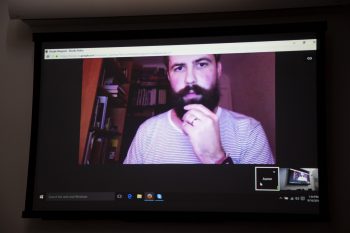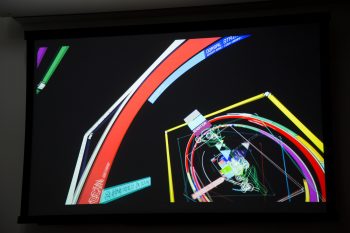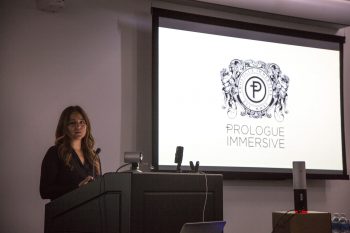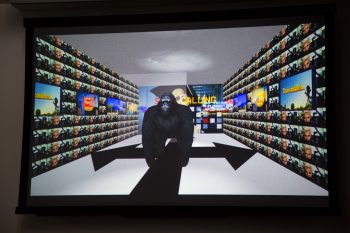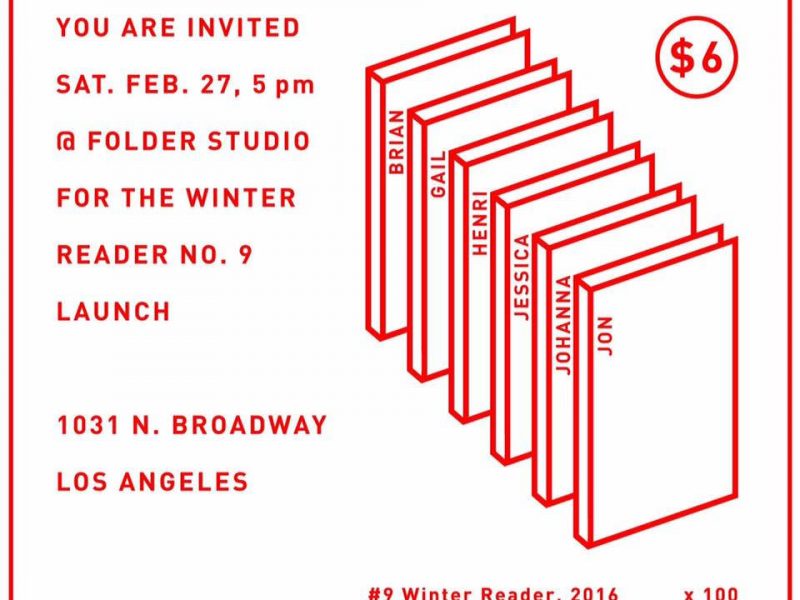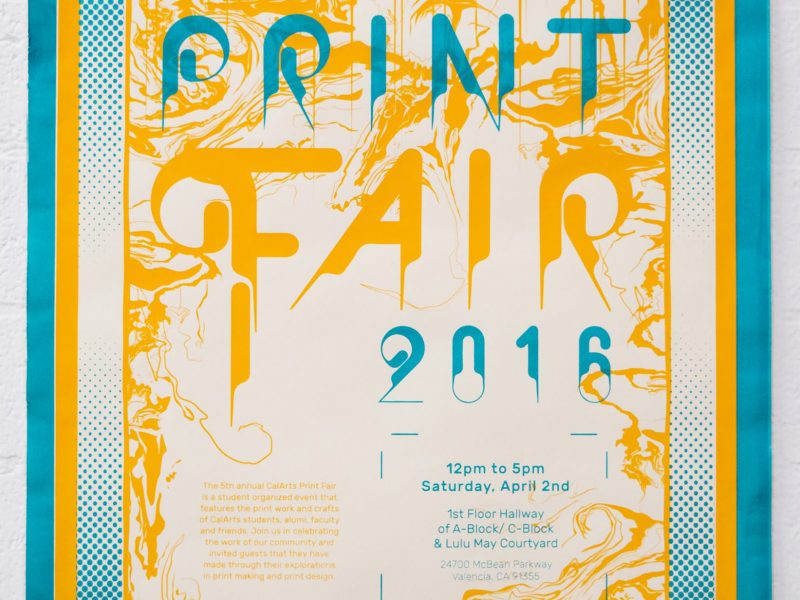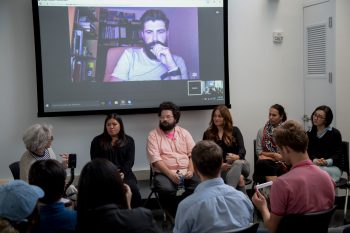
360 panelists (L to R): Louise Sandhaus, Graphic Design faculty; Jamie van Wart, Blind, CalArts alum; Joshua Walton, Creative Director of Microsoft HoloLens; Kimberly Cooper, Co Founder & CEO of Prologue Immersive; Kat Catmur, CalArts alum; Jessica Lee, CalArts alum; Aaron Bradbury (on screen), VFX supervisor at National Space Centre Creative.
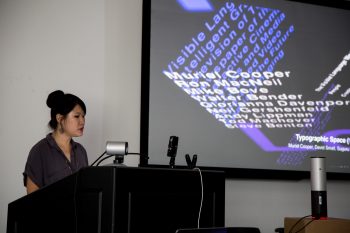
MFA student Sharleen Chen provides a contextual overview of typography in digital space.
Last Friday, Louise Sandhaus hosted 360: Type in Virtual Spaces, a series of presentations and a panel conversation concerning typography in digital and immersive spaces, at the Generator Building on the CalArts campus. The event was conceived by Sandhaus in the Spring semester along with MFA students Jessica Lee, Jaime van Wart, Sharleen Chen and Sean Kasa.
The event kicked off with intros by Graphic Design Program Co-Director Anther Kiley and 360 co-organizer Louise Sandhaus, followed by an overview of seminal projects that use type in digital spaces, delivered by current MFA student and event co-organizer Sharleen Chen. The speakers who followed were fast and focussed, each picking an aspect of this burgeoning area to investigate in more depth. Put together, this series of mini-lectures formed a unique overview of where VR/AR stands in relation to typography, covering a micro to macro range, from letterform design to complex narratives.
Aaron Bradbury appeared onscreen from the UK, and delved into the topic of immersive storytelling. He showed his short film LoVR as an example of experiential text, where the words and sensations they describe are intrinsically linked. His discussions of cognitive reinforcement and intimate space highlighted his interest in the poetic textual experience, his goal being the the creation of an experience that melds mental immersion (reading text/the story) with physical immersion (experiencing space/the feeling).
Kat Catmur (MFA 15) presented a series of etymological and typographic experiments that investigated the intersection of technology and humanism i.e. the digital eye versus the biological eye. Her typographic posters delved into the question whether code could be used poetically, existing somewhere between the page and the screen. The posters utilized glitches in AR translation software, creating forms where only the digital eye could complete the design of the poster, and see all the typographic elements. Kat shared her fascinating process which involved “collaborating” with the software, where essentially she was designing forms for the software to “read/see/react to” that she could only see through the altered digital eye of the phone screen.
Kimberly Cooper Co Founder of Prologue Immersive, presented a series of projects, both finished and in development, to talk about spatial design in VR and AR. The work represented where type in VR stands in the context of the polished commercial world, whether it was stop frame animation shot in VR, flat animation or 3d. Kimberly highlighted the problems of working with new technology that is still in its infancy, while dealing with large-scale commercial projects. In many ways the range of techniques seemed to be a search for ways to overcome the limitations of the technology, and reminded me of the struggles of early days of onscreen interactive design where technological problem solving and formal and narrative experimentation went hand-in-hand as designers tried to forge the foundations of a new area of practice.
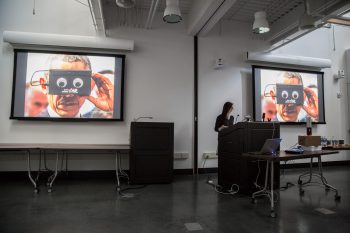
MFA alum Jessica Lee discusses typography in a VR environment
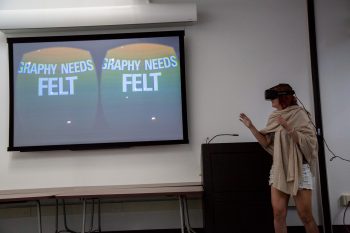
MFA student Sara Bierstecker acts as human guinea pig Jessica Lee’s Type Wonderland
Jessica Lee (MFA 2016) presented her thesis explorations entitled Type Wonderland, a series of VR typographic works looking at the rules of reading, expression and functionality in the VR world. Current student Sara Bierstecker acted as the volunteer to experience the explorations in virtual reality, while the rest of the audience got some comic relief from her gasps and exclamations. While Jessica’s explorations were clearly non-commercial and somewhat preliminary, they highlight an important playground for typography, where print, motion, interactive, environmental and narrative aspects of type are melded together in this “wonderland”.
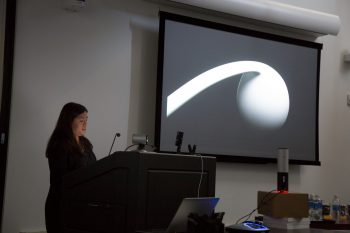
MFA alum Jamie van Wart discusses the implications for ball terminals in 3-d
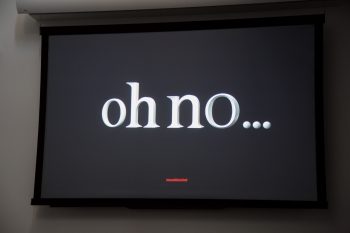
Designing type for the 3-d environment creates a multitude of problems that the “native” type designer needs to solve
Jamie van Wart (MFA 2016) presented work from her thesis project that looks at Dimensional Type Design. Following a brief history of the trompe l’oeil 3-d effects used in printed type, Jaime walked us through some of the issues in creating a typeface that is native to 3-d, and can be viewed from any angle. Jaime viewed the problem from the perspective of the functional type designer (rather than an more illustrative approach), looking at the details of the construction of letterforms in space, and seemingly opening a gigantic can of worms! Jaime’s presentation pointed to the huge difficulties in trying to import the legible or well-constructed forms of 2-d into the fully immersive environment, and left us with the question of how letters—our essential building blocks of reading—will exist in this new space.
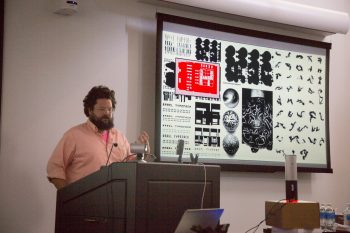
Joshua Walton, Creative Director of Microsoft HoloLens presents some early interactive type experiments
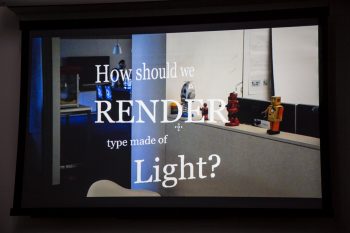
Virtual type anchored to a physical place with HoloLens
Joshua Walton, Creative Director of Microsoft HoloLens presented a condensed visual thread of his journey from undergrad at MCAD, masters at Cranbrook, his work in experience design at Rockwell NY, to his three year stint at Microsoft working with HoloLens. Josh’s interest in graphic design and the physical built environment, coupled with generative software skills, seem to make him an ideal designer for this environment. His energy and enthusiasm were coupled with a “laboratory” approach to solving design problems, and the physical nature of the work clearly excited the audience.
The afternoon ended with a brief discussion between the panelists, moderated by organizer Louise Sandhaus, before the crowd divided into smaller groups for more intimate discussions.
I left the event feeling inspired, but the lingering questions for me centered around my desire to see typography in a form “native” to this new technology. As with all new technologies in their infancy, we are currently importing old models from previous technologies (both print and screen). I wonder what will type’s role be in this new environment? The opportunities for both functional and poetic typography seem immense, but the expansion of the skill set needed to create a truly native typographic experience—motion, interactive, narrative, type design, experience, UI/UX—may be more than most individuals can deal with. If only we could merge the collected skills of all of 360s participants into one super-typographer. Maybe in VR.
